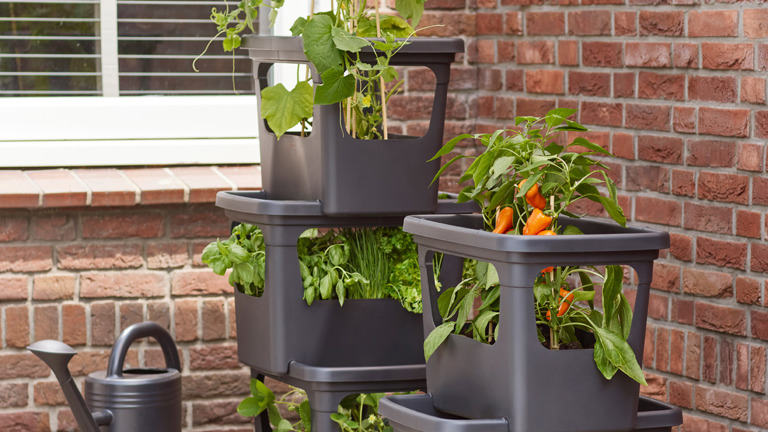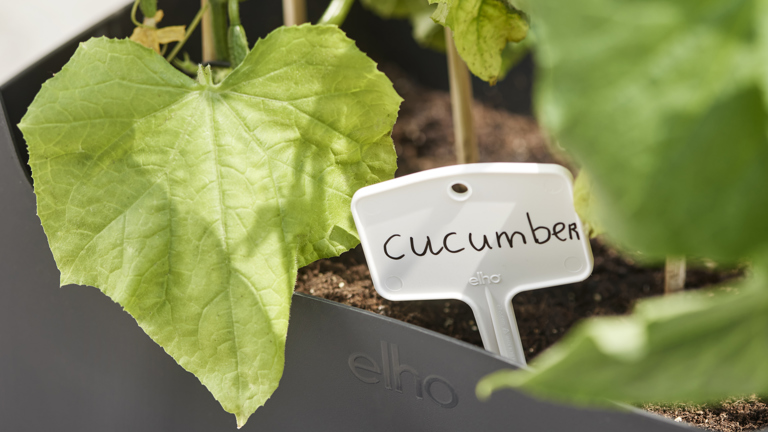
Stack & grow : the optimal “tetris” wall to grow your veggies & fruits
Have you ever looked at your balcony walls, wondering how you could leverage this space to grow food?
On top of your floor space, one of the most precious resources on a tiny balcony is your vertical space. By looking at your walls, simply imagine how you could turn this “lost” space into a growing area welcoming many new vegetables and fruits!
That’s where stack & grow will be a huge help for you to optimise & leverage this vertical space. And you won’t have any holes to do in the walls or complicated & exhausting handiwork. If you were good at playing Tetris (guess you will now have this iconic song back in your mind?), these fully recycled plastic boxes will be a fun & extremely efficient way to build your own veggie wall.
You simply have to pile them up and they will adapt to your surface, it’s up to you to decide how tall or wide your veggie wall will be. You can stack them up both horizontally or vertically. Stack up to 3 boxes on top of each other. These smart boxes come with drainage holes at their bottom, allowing the lower boxes to benefit from the excess drained water from the upper ones. Simple & efficient!

What can i grow in there?
The stack & grow containers have a soil volume of 15L which is giving you many options. From fruits to kitchen herbs to vegetables, the choice will be yours!
As for other pots & grow tables, you simply have to respect a maximum quantity of plants per container. If you read some of my previous articles, it’s important to prioritise quality over quantity. Give room to nature so that your plants have enough soil volume to grow healthily.
To inspire you, please find below a chart with the right quantity of plants you can have per stack & grow container.
|
Vegetables |
Dwarf Tomatoes |
x2 |
|
Spinach |
x4 |
|
|
Radishes |
x15 |
|
|
Lettuce |
x4 |
|
Chard |
x2 |
|
|
Mizuna |
x6 |
|
|
Sorrel |
x4 |
|
|
Pak Choi |
x4 |
|
|
Fruits |
Strawberries |
x2 |
|
Kitchen herbs |
Basil |
x4 |
|
Rosemary |
x2 |
|
|
Mint |
x4 |
|
|
Lemon Balm |
x4 |
|
|
Parsley |
x4 |
|
|
Coriander |
x4 |
What is the optimal stack & grow setup?
There is no optimal setup as you will be the one deciding what fits best to your growing space, by playing around with the boxes. But I would definitely recommend paying particular attention to sun exposure depending on which varieties you decide to grow.
The great news is that your stack & grow wall is fully flexible, you can rearrange the setup how you wish to, by interchanging the placement of your boxes.
Dwarf tomatoes need a lot of sun to grow healthily, lettuce or chard will need less sun. So you can basically switch & interchange the places of these boxes to give to your plants this optimal sun exposition spot they need.
As for everything in nature, observation is key! Inspect your baby plants regularly & experiment to see what is the best spot which will make them fully happy.

The growing season is over, what now?
When the growing season has come to an end, and yes it’s always too fast than we would love to, I know! Simply remove the roots of your plants from the stack & grow boxes. Put the remaining soil & the roots together into a big bag. They will decompose, enriching the soil. Add in there some coffee grounds or used tea bags, this will put the soil at rest, while being fed with nitrogen. This soil can be reused for the coming growing seasons to be put again in the stack & grow boxes as long as you fertilise the soil accordingly at the beginning of the next season.
You can then gain back all this space by piling up your stack & grow boxes as regular boxes, they are also great for storage!
Happy Growing & Green Love to you! The Frenchie Gardener
Patrick Vernuccio, known as “The Frenchie Gardener” on Instagram, is an Urban Gardener based in Berlin. He transformed his 18 sqm balcony into a green jungle in which he is growing organic seasonal vegetables & fruits. He waited 36 years to plant his first seed and is now advocating to welcome back Nature into our cities and our lives, to recreate this essential connection with food, seasons & ecosystems. Patrick is spreading Green Love through his successful instagram channel, writing for gardening magazines, teaching online gardening class and is certified of Permaculture Design Course. You can find more info on his website www.thefrenchiegardener.com